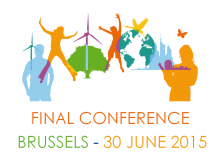Climate policy is at a crossroads, in the EU and more broadly in the world. Diverging tendencies and options indicate different directions for the development of instruments and technologies. Such issues are not just administrative and technical but also link to the governance structure. When considering climate policy instrumentation, we need governance story lines in which to place different scenarios for instrument development.
Four feasible story lines have been developed in this study. Each story line shows a different direction for the development of governance for climate policy implementation and leads to core options for policy instrumentation such as instrument Building Blocks. The baseline for all story lines and scenario development that has been applied in this study involves the condition that each scenario could reach the 2 degrees target of climate stabilization.
The first option has a technology specific focus, called the Planning Federation. It involves instruments that stimulate or force specific technologies and products into the market. The second option is the Liberal Market Federation. This option leaves technologies more open, with stronger generic incentives in a market structure, by encompassing emission pricing. The third option is called the Mixed System. In this scenario different levels of policy and instrumentation are accepted. The major initiatives are coming from the member state level and the EU has a core coordinating role to align the national policies within an overall EU framework. It is the Mixed System we are mainly in now. The fourth option builds on a Re-Nationalized EU in which the development of climate policies is mainly pursued at the national level, while the EU has the role of a coordinator.
The story lines that have been developed within the scope of this study should be regarded as scenarios that indicate possible directions for development. Each option has its strengths and weaknesses but are not blueprints. However, the governance storylines have been developed in a way that their probability is well above zero and they can be regarded as a powerful tool to develop options for policy instrumentation. Because of this, they are highly relevant when bringing climate policy instruments in the domain of governance discussion.
Attachment:
Citation:
Funding:
Year of publication:
Number of pages:
Table of contents:
|
|
Executive summary |
6 |
|
1. |
Governance scenarios and instrument types for building blocks in climate policy |
18 |
|
2. |
Governance story lines and scenarios for climate policy instrumentation |
24 |
|
3. |
Governance dimensions for climate instrument scenarios |
28 |
|
3.1. |
General considerations |
29 |
|
3.2. |
Current IPCC approaches |
35 |
|
3.3. |
Scenario family dimensions: supranationality; markets & planning; and administrative capacity |
37 |
|
3.4. |
EU governance in a multi-country context |
37 |
|
3.5. |
Four directions for EU governance development |
39 |
|
3.6. |
Four story lines for EU governance |
41 |
|
3.6.1. |
Market Federation |
41 |
|
3.6.2. |
Planning Federation |
42 |
|
3.6.3. |
Mixed System |
42 |
|
3.6.4. |
Re-Nationalized Europe |
43 |
|
3.7. |
Exemplary: ETS development in different governance scenarios |
44 |
|
4. |
A hierarchy of basic instrument types |
46 |
|
4.1. |
From institutional framework to inducing market introduction of innovations |
48 |
|
4.2. |
Exemplary filling in of instrument types |
49 |
|
4.2.1. |
Institutional Framework |
49 |
|
4.2.2. |
Internalization of climate effects through GHG emission pricing |
51 |
|
4.2.3. |
Infrastructure for public and private use |
53 |
|
4.2.4. |
Basic research and development |
54 |
|
4.2.5. |
Technology specifications overruling market behavior |
54 |
|
4.2.6. |
Innovation implementation |
55 |
|
4.3. |
Building blocks and instrument mixes |
56 |
|
5. |
Instrument building blocks for four EU governance story lines |
58 |
|
5.1. |
Instrument Building Blocks for the Market Federation |
60 |
|
5.2. |
Instrument Building Blocks for the Planning Federation |
62 |
|
5.3. |
Instrument Building Blocks for the Mixed System |
64 |
|
5.4. |
Instrument Building Blocks for the Re-Nationalized EU |
67 |
|
5.5. |
Comparison of building blocks between governance scenarios |
69 |
|
6. |
Conclusions |
72 |
|
|
References |
74 |
|
|
Annex 1 Instrument building blocks for electricity policy in four governance scenarios |
79 |
|
|
Governance based institutional development of smart EU electricity markets sketched |
79 |
|
|
Introduction |
79 |
|
|
Discussion on flexibility in electricity markets in the EU and the US |
81 |
|
|
Technical-economic requirements on the electricity system |
83 |
|
|
Governance options considered |
85 |
|
|
A cost-effective market system |
86 |
|
|
Market Federation |
87 |
|
|
Planning Federation |
89 |
|
|
Mixed Governance and Re-Nationalised EU |
90 |
|
|
Summary |
91 |
|
|
Annex 2 Instrument building blocks for road transport policy in four governance scenarios |
93 |
|
|
Instruments for person car transport: from fleet standards to generic pricing |
93 |
|
|
Sectoral Policy on Road Transport: Why and How? |
93 |
|
|
Fleet standards and actual use |
94 |
|
|
Mechanisms determining road transport emissions |
96 |
|
|
Carbon pricing versus fleet standards |
98 |
|
|
Costs of regulations with similar effectiveness |
101 |
|
|
Instrument building blocks relevant for road transport, per governance scenario |
101 |
|
|
Conclusions |
107 |


_Instrument%20building%20blocks%20and%20governance%20scenarios_cover_0-itok=M0wpMi4k.png)
